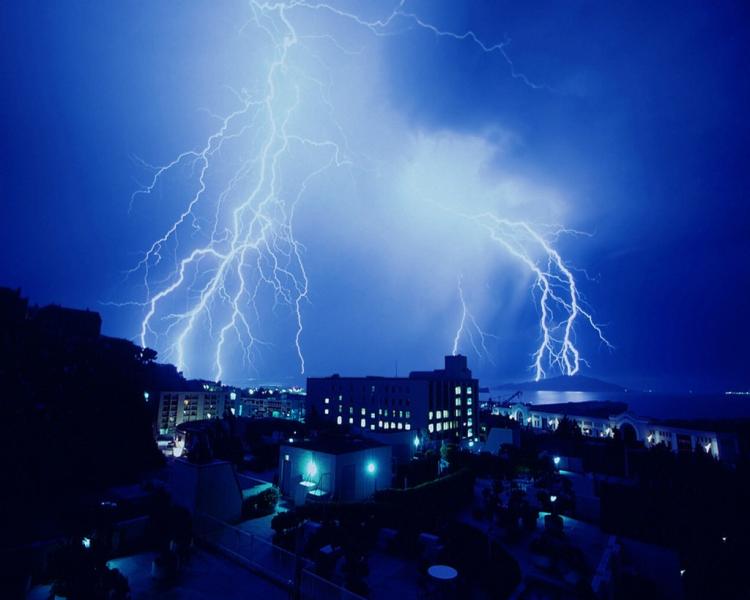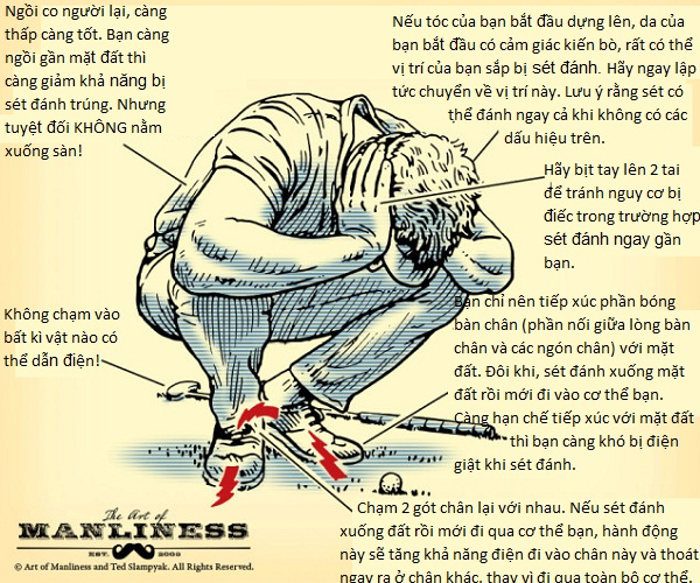Currently, it is the thunderstorm season in Vietnam, making lightning strikes a frequent occurrence that can pose serious dangers to us. However, not everyone knows how to prevent lightning strikes to ensure safety for themselves and their loved ones.
Guide to Lightning Strike Prevention Measures
What Happens When Struck by Lightning
Lightning is an electrical discharge phenomenon occurring in the atmosphere between clouds and the earth, or between clouds with opposite charges. Lightning can strike anywhere, at any object or entity when the factors necessary for lightning formation are present.
Statistics show that approximately 250,000 lightning strike incidents occur globally each year, resulting in tens of thousands of fatalities. Survivors often suffer from severe health complications.
According to Dr. Frank LoVecchio, a geologist at Banner Medical School, lightning typically causes localized burns. Some individuals may experience cardiac arrest, confusion, seizures, dizziness, muscle pain, headaches, and memory loss. Lightning strikes can also lead to cataracts, ruptured eardrums, causing lifelong hearing issues for the victims.
Fatalities usually result from cardiac arrest or respiratory failure at the moment of being struck by lightning. “The electrical current from lightning can cause cardiac arrest or irregular heartbeats. It provides the heart with energy similar to a defibrillator,” Dr. LoVecchio stated. He recommends that people call emergency services and perform artificial respiration if necessary to save the victim’s life.
How to Prevent Lightning Strikes

Absolute Lightning Protection is Not Possible
Research by the Institute of Geophysics shows that Vietnam is located in the heart of the Asian thunderstorm zone—one of the three major thunderstorm centers in the world, with significant lightning activity. The thunderstorm season in Vietnam is relatively long, averaging 100 days of thunderstorms each year and about 250 hours of thunderstorm activity annually. Each year, Vietnam experiences up to two million lightning strikes. Areas like Co Dung (Hai Duong), Son Loc (Ha Tinh), and the Mekong Delta are considered lightning hotspots.
According to Dr. Anh, since 2005, the Institute of Geophysics has completed a research project on thunderstorms and preventive measures. The research results provide sufficient data to establish lightning protection standards in Vietnam. However, Dr. Anh also believes: “Absolute lightning protection is unattainable for humanity at present. Not just in Vietnam, but globally, we can only study ways to reduce the damage from this type of natural disaster.“
Outdoor Lightning Prevention
According to scientists, thunderstorms usually approach very quickly within 15 minutes and move at a speed of 40 km/h. Generally, when in an unsafe location, one should pay attention to signs of thunderstorms such as dark clouds, cold air, and wind.
One can estimate the distance from their position to where lightning occurs by calculating the time between seeing a flash of lightning and hearing the thunder. Dividing the number of seconds by 3 gives the distance to the lightning strike. For example, if you count 3 seconds, the lightning is 3/3 = 1 km away from your position.
Additionally, there is a method to detect the location of lightning by sensing your body when in a thunderstorm area. If you feel hair on your arms or neck standing up, you are at risk of being struck by lightning; in this case, immediately bring your feet together, cover your ears with your hands, and crouch down (but do not let your body touch the ground except for your feet). After hearing thunder, wait about 7-10 minutes before returning to normal activities.

Sitting position to avoid lightning strikes
If this time is less than 20 seconds, you must move to a safer location. Upon hearing the first thunder, regardless of the cause, you should recognize that danger is imminent. Lightning can strike as far as 15-20 km from the rain area. Individuals working or moving outdoors should seek shelter immediately.
When outside, never use trees as shelter from rain, avoid areas elevated above the surroundings, and stay away from metal objects such as bicycles, machinery, and fences. It’s best to find a dry place; if there are taller trees around, seek lower ground and position yourself near shorter trees. The lower you are, the better; hug your knees with minimal contact with the ground, standing on your toes, and do not lie down on the ground. Importantly, do not stand in groups close together.
For vehicles with metal surfaces such as buses, trains, and cars, it is safe inside as long as you do not stick your body out and do not touch the metal exterior. Conversely, open or non-metal-bodied vehicles are dangerous.
After hearing thunder for 30 minutes, it is safe to return to normal activities.
Indoor Lightning Prevention
However, when a thunderstorm is imminent, the best way to prevent lightning strikes is to return home or to your workplace. Buildings and workplaces should install lightning protection systems (the simplest being lightning rods).
When indoors, stay away from windows, doors, and electrical appliances, avoid damp areas such as bathrooms, water tanks, and faucets, and refrain from using the phone unless absolutely necessary. It’s advisable to unplug electrical devices before thunderstorms occur. Telephone lines or electrical wires connected to the outside grid can be affected by lightning strikes, so maintain a distance of at least 1 meter from these and any electrical appliances. Remove antennas from televisions when thunderstorms are near.
If you feel your hair standing on end (similar to a static electric shock when touching a TV screen), this means you could be struck by lightning at any moment; immediately crouch down, cover your ears, and do not lie down or place your hands on the ground.

When encountering a lightning strike victim, check if they are breathing. (Illustrative image).
How to First Aid Lightning Strike Victims
When encountering a person struck by lightning, if the victim is unconscious, check if they are breathing. If they are not breathing, immediate cardiopulmonary resuscitation (CPR) is required.
- Place the victim on their back.
- Perform mouth-to-mouth resuscitation: Pinch the victim’s nose, take a deep breath, seal the victim’s mouth, and blow a long breath into their mouth, then let them exhale normally. Continue this process about twice.
- Perform chest compressions: Locate the lower third of the sternum. Place both hands on this location and compress continuously about 30 times at a rate of about 100 compressions per minute, pressing down about 3-5 cm.
- Alternate between rescue breaths and compressions at a ratio of 2 breaths to 30 compressions until medical personnel arrive with necessary equipment.
- Stabilize the victim’s neck and back if there are suspected head or neck injuries with swelling and bleeding.
- If the victim has burns, allow them to dry naturally; do not apply any ointments or folk remedies to prevent infection.
- If the victim’s clothes or shoes are burnt due to lightning, remove fabric from the wound and take off jewelry to prevent pressure on the injury.
- Do not let the victim eat or drink if they are not conscious, have injuries, or are vomiting.
- Note that after providing first aid, you must quickly transport the victim to the nearest medical facility.
454 lightning strikes on the ground in Hanoi in just 10 minutes
What is thunder? Why does thunder occur?
Most susceptible cases to lightning strikes that you must remember




















































